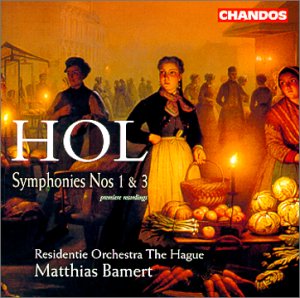Richard HOL: Symphony No.1 in C
minor; Symphony No.3 in B
flat
 Residentie Orchestra The
Hague/Matthias Bamert
Residentie Orchestra The
Hague/Matthias Bamert
 CHANDOS CHAN 9796 [54'58"]
CHANDOS CHAN 9796 [54'58"]

MILKMAN'S SON - SUCCESSFUL MUSICIAN - DEAD. So a Dutch tabloid might have
headlined Richard Hol's demise, aged 79, in 1904. Despite Hol's indigenous
achievements as composer, conductor, pianist and educator, these two symphonies
are only now receiving their first recording; and I had a blank reaction
when scanning Chandos's release sheets. Nevertheless I'm always on the lookout
for unfamiliar music and musicians - being curious finds you wonderful
discoveries. These two Hol symphonies are not quite that though.
This is the first release of a Chandos series devoted to 19th- and 20th-century
Dutch music. Not surprisingly for his era, Hol's music reveals a strong German
influence. In his booklet note, Leo Samama cites Schubert and Schumann as
references. Certainly, more the former though - and like Schubert, Hol can
be repetitive - but I would say a stronger link is Weber. The pensive slow
introduction to the C minor piece suggests Der Freischutz's Overture; in
the ensuing, breezy Allegro, Hol's scoring has similarities with Weber's.
For a 38-year-old, Hol's First Symphony is a tad too apprentice-like, short
on really strong ideas if not unattractive tunes; the development of the
first movement relies on fugato recall of incipient material rather than
a transformation of it. The song-like slow movement, for all its charm, doesn't
quiet blossom as it initially suggests. The scherzo (which I feel Bamert
could have taken a little faster) sounds like a slightly sinister version
of "The Teddy Bears' Picnic" - the words `If you go down to the woods
today…' came to mind! More pertinently there's more than a suggestion
here of the scherzos of Berwald's Singuliere and E flat Symphonies - especially
the latter (masterpieces both, Sixten Ehrling's inspired BIS recordings the
unequivocal first choice) - but Hol doesn't emulate Berwald's astonishing
lightness of touch, harmonic interest or instrumental incident. Bamert sweeps
attacca into the finale's dramatic opening. This quasi-operatic prelude
soon yields to a main idea that proves to be a first cousin to the scherzo,
a dynamic movement that journeys to it close in some style.
The 1884 B flat Symphony is a more ambitious piece, if not much longer at
30 minutes. 59-year-old Hol is now less reliant on Germanic influence. He
has not only found a more individual voice and greater confidence, he is
- by accident or design - echoing Tchaikovsky, Sullivan (without Gilbert),
Parry and even anticipating early Elgar. The first movement is an altogether
assured piece with an aspirational development section. I did raise a smile
come the scherzo - we're off down to the woods again! I suspect this
sub-Mendelssohnian movement was composed much earlier than its companions
were (Samama opines 1867 marked this Symphony's gestation). The `landscape
at dusk' (my description) slow movement - achieved by some lovely string
writing - is quite personal. This movement may lose direction but is made
curious by two puckish, charming interludes. The last movement combines the
talents of Bizet and Gounod with a dash of Sullivan; it trips along very
happily. A couple of moments aside when Hol suggests he is going to be
portentous, the closing bars have a Dvorakian lilt.
Anyone interested in, say, Berwald, Bruch and Glazunov - and the 19th-century
symphony in general - will find this Chandos release rewarding. Hopefully
Hol's remaining two symphonies will follow. Bamert conducts fine performances
with Chandos providing excellent sound.
Reviewer
Colin Anderson


![]()